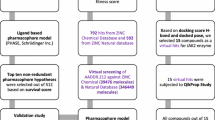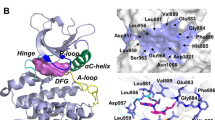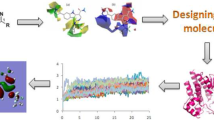Abstract
Janus kinase 2 (JAK2) inhibitors are potential anticancer drugs in the treatment of lymphoma, leukemia, thrombocytosis and particularly myeloproliferative diseases. However, the resemblance among JAK family members has challenged the identification of highly selective inhibitors for JAK2 to reduce undesired side effects. As a result, a robust search for promising JAK2 inhibitors using a computational approach that can effectively nominate new potential candidates to be further analyzed through laborious experimental operations has become necessary. In this study, the binding affinities of JAK2 inhibitors were rapidly and precisely estimated using the fast pulling of ligand (FPL) simulations combined with a modified linear interaction energy (LIE) method. The approach correlates with the experimental binding affinities of JAK2 inhibitors with a correlation coefficient of R = 0.82 and a root-mean-square error of 0.67 kcal•mol−1. The data reveal that the FPL/LIE method is highly approximate in anticipating the relative binding free energies of known JAK2 inhibitors with an affordable consumption of computational resources, and thus, it is very promising to be applied in in silico screening for new potential JAK2 inhibitors from a large number of molecules available.







Similar content being viewed by others
Data availability
The authors confirm that the data supporting the findings of this study are available within the article and its supplementary materials.
Code availability
The code generated during the current study is available from the corresponding author on reasonable request.
References
Yu W, MacKerell AD Jr (2017) Computer-Aided Drug Design Methods. Methods Mol Biol 1520:85–106
Marshall GR (1987) Computer-aided drug design. Annu Rev Pharmacol Toxicol 27:193–213
Homeyer N, Stoll F, Hillisch A, Gohlke H (2014) Binding free energy calculations for lead optimization: assessment of their accuracy in an industrial drug design context. J Chem Theory Comput 10:3331–3344
Lengauer T, Rarey M (1996) Computational methods for biomolecular docking. Curr Opin Struct Biol 6:402–406
Pagadala NS, Syed K, Tuszynski J (2017) Software for molecular docking: a review. Biophys Rev 9:91–102
Hansch C, Leo A, Hoekman D (1995) Exploring QSAR: fundamentals and applications in chemistry and biology. American Chemical Society Washington, DC
Åqvist J, Medina C, Samuelsson J-E (1994) A new method for predicting binding affinity in computer-aided drug design. Protein Eng Des Sel 7:385–391
Aqvist J, Marelius J (2001) The linear interaction energy method for predicting ligand binding free energies. Comb Chem High Throughput Screen 4:613–626
Åqvist J, Luzhkov VB, Brandsdal BO (2002) Ligand binding affinities from MD simulations. Acc Chem Res 35:358–365
Genheden S, Ryde U (2015) The MM/PBSA and MM/GBSA methods to estimate ligand-binding affinities. Expert Opin Drug Discov 10:449–461
Homeyer N, Gohlke H (2012) Free energy calculations by the molecular mechanics Poisson− Boltzmann surface area method. Mol Inf 31:114–122
Zwanzig RW (1954) High-temperature equation of state by a perturbation method. I Nonpolar gases J Chem Phys 22:1420–1426
Kirkwood JG (1935) Statistical mechanics of fluid mixtures. J Chem Phys 3:300–313
Ngo ST, Nguyen TH, Tung NT, Nam PC, Vu KB, Vu VV (2020) Oversampling Free Energy Perturbation Simulation in Determination of the Ligand-Binding Free Energy. J Comput Chem 41:611–618
Uciechowska U, Schemies J, Scharfe M, Lawson M, Wichapong K et al (2012) Binding free energy calculations and biological testing of novel thiobarbiturates as inhibitors of the human NAD+ dependent histone deacetylase Sirt2. MedChemComm 3:167–173
Kuhn B, Kollman PA (2000) Binding of a diverse set of ligands to avidin and streptavidin: an accurate quantitative prediction of their relative affinities by a combination of molecular mechanics and continuum solvent models. J Med Chem 43:3786–3791
Ngo ST, Mai BK, Derreumaux P, Vu VV (2019) Adequate prediction for inhibitor affinity of Aβ 40 protofibril using the linear interaction energy method. RSC Adv 9:12455–12461
Genheden S, Ryde U (2011) Comparison of the efficiency of the LIE and MM/GBSA methods to calculate ligand-binding energies. J Chem Theory Comput 7:3768–3778
Wang J, Dixon R, Kollman PA (1999) Ranking ligand binding affinities with avidin: a molecular dynamics-based interaction energy study. Proteins: Struct Funct Bioinform 34:69–81
Wall ID, Leach AR, Salt DW, Ford MG, Essex JW (1999) Binding constants of neuraminidase inhibitors: an investigation of the linear interaction energy method. J Med Chem 42:5142–5152
Ngo ST, Nguyen MT, Nguyen MT (2017) Determination of the absolute binding free energies of HIV-1 protease inhibitors using non-equilibrium molecular dynamics simulations. Chem Phys Lett 676:12–17
Ngo ST, Hung HM, Nguyen MT (2016) Fast and accurate determination of the relative binding affinities of small compounds to HIV-1 protease using non-equilibrium work. J Comput Chem 37:2734–2742
Mai NT, Lan NT, Vu TY, Duong PTM, Tung NT, Phung HTT (2020) Estimation of the ligand-binding free energy of checkpoint kinase 1 via non-equilibrium MD simulations. J Mol Graph Model 100:107648
Aaronson DS, Horvath CM (2002) A road map for those who don’t know JAK-STAT. Science 296:1653–1655
Rawlings JS, Rosler KM, Harrison DA (2004) The JAK/STAT signaling pathway. J Cell Sci 117:1281–1283
Leonard WJ, O’Shea JJ (1998) Jaks and STATs: biological implications. Annu Rev Immunol 16:293–322
Mascarenhas J, Mughal TI, Verstovsek S (2012) Biology and clinical management of myeloproliferative neoplasms and development of the JAK inhibitor ruxolitinib. Current medicinal chemistry 19:4399–4413
O’Shea JJ, Holland SM, Staudt LM (2013) JAKs and STATs in immunity, immunodeficiency, and cancer. New Engl J Med 368:161–170
Banerjee S, Biehl A, Gadina M, Hasni S, Schwartz DM (2017) JAK–STAT signaling as a target for inflammatory and autoimmune diseases: current and future prospects. Drugs 77:521–546
Menet CJ, Van Rompaey L, Geney R (2013) Advances in the discovery of selective JAK inhibitors. In Prog Med Chem 52:153–223 (Elsevier. Number of 153-223 pp.)
Verstovsek S (2009) Therapeutic potential of JAK2 inhibitors. ASH Education Program Book 2009:636–642
Verma A, Kambhampati S, Parmar S, Platanias LC (2003) Jak family of kinases in cancer. Cancer Metastasis Rev 22:423–434
Kiss R, Sayeski PP, Keserű GM (2010) Recent developments on JAK2 inhibitors: a patent review. Expert Opin Ther Pat 20:471–495
Santos FP, Verstovsek S (2011) JAK2 inhibitors: are they the solution? Clin Lymphoma Myeloma Leuk 11:S28–S36
Leroy E, Constantinescu SN (2017) Rethinking JAK2 inhibition: towards novel strategies of more specific and versatile janus kinase inhibition. Leukemia 31:1023–1038
Buchert M, Burns C, Ernst M (2016) Targeting JAK kinase in solid tumors: emerging opportunities and challenges. Oncogene 35:939–951
Mesa RA, Yasothan U, Kirkpatrick P (2012) Ruxolitinib. Nat Rev Drug Discov 11:103–104
Wu P, Nielsen TE, Clausen MH (2015) FDA-approved small-molecule kinase inhibitors. Trends Pharmacol Sci 36:422–439
Williams NK, Bamert RS, Patel O, Wang C, Walden PM et al (2009) Dissecting specificity in the Janus kinases: the structures of JAK-specific inhibitors complexed to the JAK1 and JAK2 protein tyrosine kinase domains. J Mol Biol 387:219–232
Ledeboer MW, Pierce AC, Duffy JP, Gao H, Messersmith D et al (2009) 2-Aminopyrazolo [1, 5-a] pyrimidines as potent and selective inhibitors of JAK2. Bioorg Med Chem Lett 19:6529–6533
Wang T, Duffy JP, Wang J, Halas S, Salituro FG et al (2009) Janus kinase 2 inhibitors. Synthesis and characterization of a novel polycyclic azaindole. J Med Chem 52:7938–7941
Wang T, Ledeboer MW, Duffy JP, Pierce AC, Zuccola HJ et al (2010) A novel chemotype of kinase inhibitors: Discovery of 3, 4-ring fused 7-azaindoles and deazapurines as potent JAK2 inhibitors. Bioorg Med Chem Lett 20:153–156
Guan H, Lamb ML, Peng B, Huang S, DeGrace N et al (2013) Discovery of novel Jak2–Stat pathway inhibitors with extended residence time on target. Bioorg Med Chem Lett 23:3105–3110
Kulagowski JJ, Blair W, Bull RJ, Chang C, Deshmukh G et al (2012) Identification of imidazo-pyrrolopyridines as novel and potent JAK1 inhibitors. J Med Chem 55:5901–5921
Zak M, Mendonca R, Balazs M, Barrett K, Bergeron P et al (2012) Discovery and optimization of C-2 methyl imidazopyrrolopyridines as potent and orally bioavailable JAK1 inhibitors with selectivity over JAK2. J Med Chem 55:6176–6193
Liang J, Tsui V, Van Abbema A, Bao L, Barrett K et al (2013) Lead identification of novel and selective TYK2 inhibitors. Eur J Med Chem 67:175–187
Hanan EJ, van Abbema A, Barrett K, Blair WS, Blaney J et al (2012) Discovery of potent and selective pyrazolopyrimidine janus kinase 2 inhibitors. J Med Chem 55:10090–10107
Siu M, Pastor R, Liu W, Barrett K, Berry M et al (2013) 2-Amino-[1, 2, 4] triazolo [1, 5-a] pyridines as JAK2 inhibitors. Bioorg Med Chem Lett 23:5014–5021
Farmer LJ, Ledeboer MW, Hoock T, Arnost MJ, Bethiel RS et al (2015) Discovery of VX-509 (decernotinib): a potent and selective Janus kinase 3 inhibitor for the treatment of autoimmune diseases. J Med Chem 58:7195–7216
Liang J, Van Abbema A, Balazs M, Barrett K, Berezhkovsky L et al (2017) Identification of an imidazopyridine scaffold to generate potent and selective TYK2 inhibitors that demonstrate activity in an in vivo psoriasis model. Bioorg Med Chem Lett 27:4370–4376
Lindorff-Larsen K, Piana S, Palmo K, Maragakis P, Klepeis JL et al (2010) Improved side-chain torsion potentials for the Amber ff99SB protein force field. Proteins 78:1950–1958
Case DA, Ben-Shalom IY, Brozell SR, Cerutti DS, Cheatham TE et al (2018) AMBER 18. University of California, San Francisco
Sousa da Silva AW, Vranken WF (2012) ACPYPE - AnteChamber PYthon Parser interfacE. BMC Res Notes 5:1–8
Bayly CI, Cieplak P, Cornell W, Kollman PA (1993) A well-behaved electrostatic potential based method using charge restraints for deriving atomic charges: the RESP model. J Phys Chem 97:10269–10280
Zhang H, Yin C, Jiang Y, van der Spoel D (2018) Force Field Benchmark of Amino Acids: I. Hydration and Diffusion in Different Water Models. J Chem Inf Model 58:1037–1052
Zhang H, Jiang Y, Cui Z, Yin C (2018) Force Field Benchmark of Amino Acids. 2. Partition Coefficients between Water and Organic Solvents. J Chem Inf Model 58:1669–1681
Jorgensen WL, Chandrasekhar J, Madura JD, Impey RW, Klein ML (1983) Comparison of simple potential functions for simulating liquid water. J Chem Phys 79:926–935
Shrake A, Rupley JA (1973) Environment and exposure to solvent of protein atoms. Lysozyme and insulin. J Mol Biol 79:351–371
Sitkoff D, Sharp KA, Honig B (1994) Accurate calculation of hydration free energies using macroscopic solvent models. J Phys Chem 98:1978–1988
Mai BK, Viet MH, Li MS (2010) Top leads for swine influenza A/H1N1 virus revealed by steered molecular dynamics approach. J Chem Inf Model 50:2236–2247
Mai BK, Li MS (2011) Neuraminidase inhibitor R-125489–a promising drug for treating influenza virus: steered molecular dynamics approach. Biochem Biophys Res Commun 410:688–691
Ngo ST, Mai BK, Derreumaux P, Vu VV (2019) Adequate prediction for inhibitor affinity of Aβ40 protofibril using the linear interaction energy method. RSC Adv 9:12455–12461
Ngo ST, Hong ND, Hiep DM, Tung NT (2020) Effective estimation of the inhibitor affinity of HIV-1 protease via a modified LIE approach. RSC Adv 10:7732–7739
Hansson T, Marelius J, Åqvist J (1998) Ligand binding affinity prediction by linear interaction energy methods. J Comput-Aided Mol Des 12:27–35
Capoferri L, van Dijk M, Rustenburg AS, Wassenaar TA, Kooi DP et al (2017) eTOX ALLIES: an automated pipeLine for linear interaction energy-based simulations. J Cheminform 9:1–13
Jones-Hertzog DK, Jorgensen WL (1997) Binding affinities for sulfonamide inhibitors with human thrombin using Monte Carlo simulations with a linear response method. J Med Chem 40:1539–1549
Almlöf M, Brandsdal BO, Åqvist J (2004) Binding affinity prediction with different force fields: examination of the linear interaction energy method. J Comput Chem 25:1242–1254
Rastelli G, Del Rio A, Degliesposti G, Sgobba M (2010) Fast and accurate predictions of binding free energies using MM-PBSA and MM-GBSA. J Comput Chem 31:797–810
Jiang W, Roux B (2010) Free Energy Perturbation Hamiltonian Replica-Exchange Molecular Dynamics (FEP/H-REMD) for Absolute Ligand Binding Free Energy Calculations. J Chem Theory Comput 6:2559–2565
Ngo ST, Quynh Anh Pham N, Le Thi L, Pham D-H, Vu VV (2020) Computational Determination of Potential Inhibitors of SARS-CoV-2 Main Protease. J Chem Inf Model 60:5771–5780
Ngo ST, Hung Minh N, Le Thi TH, Pham Minh Q, Vi Khanh T et al (2020) Assessing Potential Inhibitors for SARS-CoV-2 Main Protease from Available Drugs using Free Energy Perturbation Simulations. RSC Adv 10:40284–40290
Author information
Authors and Affiliations
Contributions
All authors had contributed to the study’s conception and design. Material preparation, data collection and analysis were performed by Nguyen Thi Mai, Ngo Thi Lan and Thien Y Vu. The first draft of the manuscript was written by Huong Thi Thu Phung and Nguyen Thanh Tung, and all authors commented on previous versions of the manuscript. All authors read and approved the final manuscript.
Corresponding authors
Ethics declarations
Competing interests
The authors declare that they have no conflicts of interest in this work.
Additional information
Publisher's note
Springer Nature remains neutral with regard to jurisdictional claims in published maps and institutional affiliations.
Supplementary Information
Below is the link to the electronic supplementary material.
Rights and permissions
About this article
Cite this article
Mai, N.T., Lan, N.T., Vu, T.Y. et al. A computationally affordable approach for accurate prediction of the binding affinity of JAK2 inhibitors. J Mol Model 28, 163 (2022). https://doi.org/10.1007/s00894-022-05149-0
Received:
Accepted:
Published:
DOI: https://doi.org/10.1007/s00894-022-05149-0




